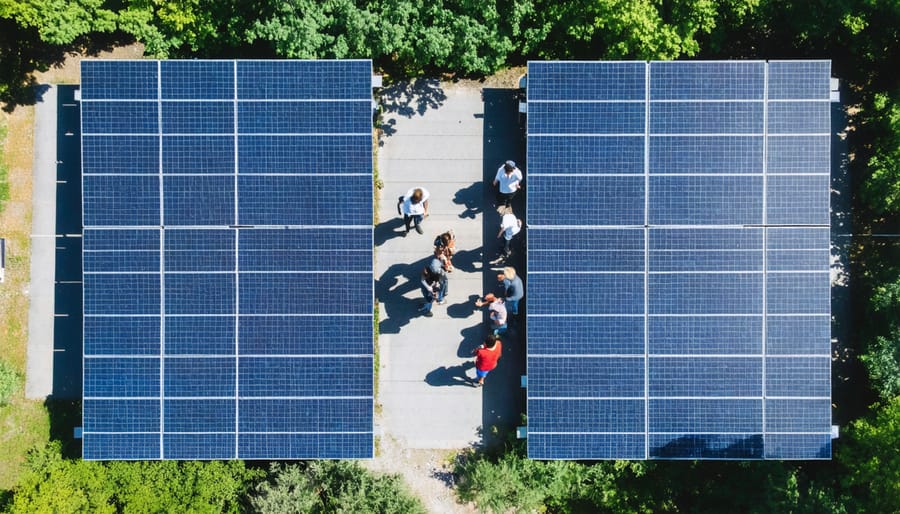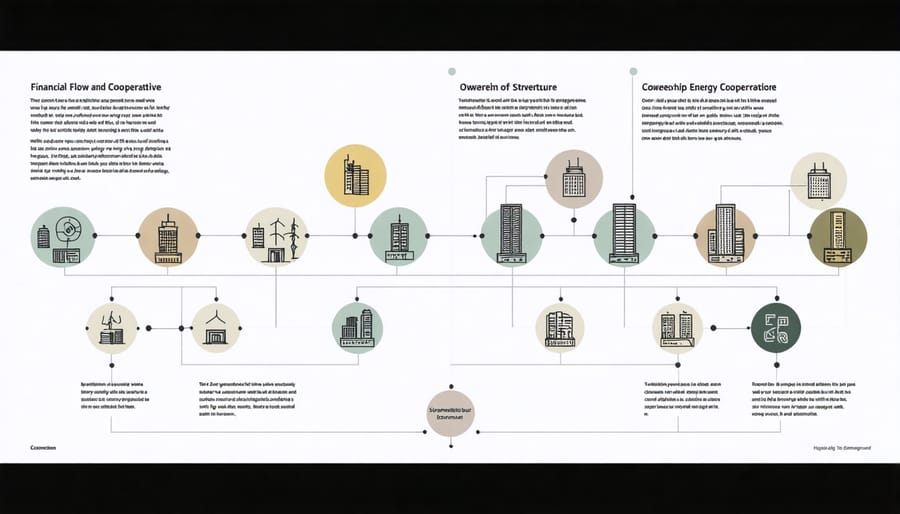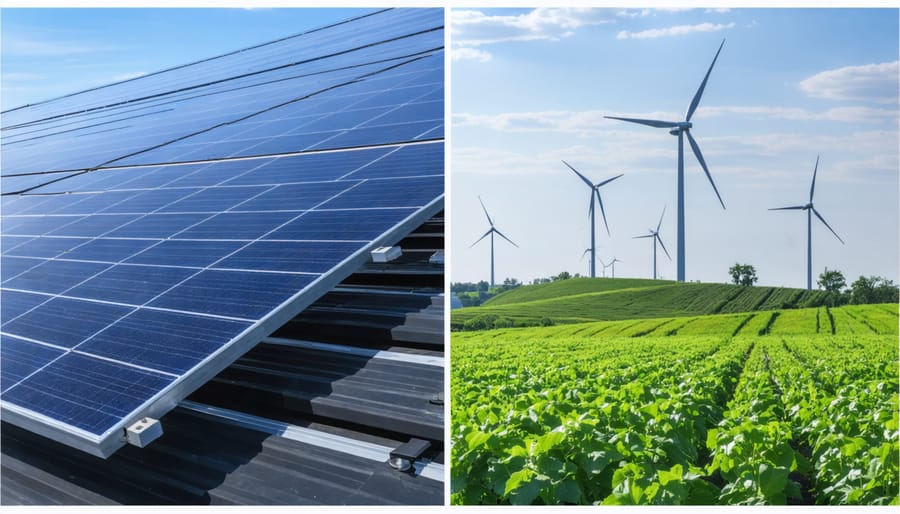Energy cooperatives are revolutionizing how communities access, manage, and benefit from renewable power resources. These member-owned organizations are transforming the traditional energy landscape by putting control directly into the hands of consumers while delivering substantial economic and environmental advantages.
As businesses and communities face mounting pressure to reduce carbon emissions and energy costs, energy cooperatives offer a compelling solution that combines democratic governance with sustainable practices. These organizations enable participants to pool resources, share risks, and collectively invest in renewable energy infrastructure that might otherwise be out of reach for individual members.
The cooperative model has already demonstrated remarkable success across Europe and North America, where thousands of communities have established their own energy initiatives. From small rural electric cooperatives powering remote areas to sophisticated urban partnerships developing commercial-scale solar installations, these organizations are proving that local, democratic energy management isn’t just possible—it’s profitable and sustainable.
With rising energy costs and increasing emphasis on environmental responsibility, energy cooperatives represent a forward-thinking approach that aligns economic interests with ecological stewardship. They offer a practical pathway for businesses and communities to take control of their energy future while contributing to global sustainability goals.
How Community Energy Co-ops Transform Local Power

Democratic Energy Ownership
Energy cooperatives operate on a democratic ownership model where members collectively own and control their energy resources. Each member typically holds one vote regardless of their investment size, ensuring equitable decision-making power across the organization. This structure enables communities and businesses to participate in circular energy solutions while maintaining local control over their energy future.
Members benefit from both economic and governance advantages. Financial returns from the cooperative’s operations are distributed to members as dividends or reinvested based on collective decisions. Additionally, members often enjoy reduced energy costs, protection against market volatility, and priority access to renewable energy services.
The cooperative model also facilitates knowledge sharing and capacity building among members. Through regular meetings and democratic processes, participants gain valuable insights into energy management, sustainability practices, and operational efficiency. This collaborative approach strengthens community resilience and supports long-term energy independence while ensuring that benefits remain within the local economy rather than flowing to distant shareholders.
Local Economic Benefits
Energy cooperatives generate substantial economic benefits for their local communities through multiple channels. Members typically experience significant reductions in energy costs, with savings often ranging from 10-30% compared to traditional utility providers. These cooperatives facilitate cost transformation through smart energy management and collective purchasing power.
The economic advantages extend beyond direct energy savings. Cooperatives create local jobs in installation, maintenance, and administration while keeping energy dollars within the community rather than flowing to distant utility companies. Revenue generated through these initiatives is reinvested locally, stimulating economic growth and development.
Members also benefit from revenue sharing when excess energy is sold back to the grid, creating a new income stream for participating businesses and organizations. The cooperative model enables smaller businesses to access renewable energy technologies that might otherwise be cost-prohibitive, leveling the playing field and enhancing local business competitiveness.
Additionally, energy cooperatives often strengthen property values and attract new businesses to the area, creating a positive economic ripple effect throughout the community.
Setting Up a Successful Energy Co-operative
Legal Framework and Requirements
Energy cooperatives operate within a well-defined legal framework that varies by jurisdiction but typically follows cooperative principles established by national and international legislation. In the European Union, energy cooperatives are governed by the Renewable Energy Directive (RED II), which recognizes and protects the rights of energy communities to generate, consume, store, and sell renewable energy.
To establish an energy cooperative, organizations must meet specific legal requirements, including registration as a cooperative entity, development of comprehensive bylaws, and compliance with energy sector regulations. The governance structure typically follows the one-member-one-vote principle, ensuring democratic control regardless of investment size.
Key legal requirements often include:
– Minimum number of founding members
– Registration with relevant authorities
– Democratic governance structure
– Transparent financial management
– Compliance with energy market regulations
– Regular reporting and auditing
The organizational structure must include a board of directors, elected by members, responsible for strategic decisions and oversight. Many jurisdictions require energy cooperatives to maintain specific financial reserves and submit regular reports to regulatory authorities.
Environmental and safety regulations play a crucial role, particularly for renewable energy installations. Cooperatives must obtain necessary permits, environmental impact assessments, and grid connection agreements. Additionally, they must comply with local zoning laws and building codes.
Tax considerations vary by region, with many jurisdictions offering incentives for renewable energy cooperatives. Understanding these frameworks is essential for successful operation and long-term sustainability. Regular legal consultation ensures ongoing compliance and adaptation to evolving regulations in the renewable energy sector.
Financial Planning and Investment
Energy cooperatives require careful financial planning and robust investment strategies to ensure long-term sustainability. The initial capital investment typically comes from member contributions, which can be structured through share purchases or membership fees. These contributions form the foundation of the cooperative’s financial resources and determine its operational capacity.
Many energy cooperatives utilize a combination of funding sources, including member equity, bank loans, and government grants. Some cooperatives implement tiered membership structures, where members can invest different amounts based on their capacity and desired level of involvement. This flexible approach helps attract diverse participants while maintaining democratic principles.
Project financing often follows a structured approach, with clear allocation of funds for equipment procurement, installation, maintenance, and operational costs. Successful cooperatives typically maintain reserve funds for unexpected expenses and future expansions. They also develop detailed financial models that account for revenue streams, including energy sales, renewable energy certificates, and potential tax incentives.
Risk management is crucial in financial planning. Cooperatives should establish contingency funds and insurance coverage to protect against equipment failures, natural disasters, or market fluctuations. Many cooperatives partner with financial institutions that specialize in renewable energy projects to secure favorable lending terms and expert guidance.
Return on investment (ROI) projections should be realistic and transparent to members. Most energy cooperatives aim for a balanced approach between immediate member benefits (such as reduced energy costs) and long-term financial sustainability. Typical payback periods range from 5-10 years, depending on project scale, technology choices, and local energy market conditions.
Regular financial audits and transparent reporting help maintain member trust and ensure compliance with regulatory requirements. This accountability is essential for attracting new members and maintaining the cooperative’s financial health.


Real-World Success Stories
Urban Solar Cooperative Case Study
The SunShare Community Solar Cooperative in Denver, Colorado, demonstrates the successful implementation of an urban energy cooperative model. Established in 2018, this cooperative now serves over 2,500 members and operates a 4.5-megawatt solar array installed across multiple commercial rooftops throughout the metropolitan area.
The cooperative’s innovative approach combines traditional membership ownership with modern technology solutions. Members invest between $1,000 and $10,000 to join, receiving both voting rights and energy credits proportional to their investment. The cooperative negotiated power purchase agreements with local businesses, utilizing their roof space for solar panel installation while providing them with discounted electricity rates.
What sets SunShare apart is its comprehensive community engagement strategy. The cooperative partnered with local workforce development programs to train and employ community members in solar installation and maintenance roles. This approach has created 35 full-time jobs while ensuring operational expertise remains within the community.
Financial performance has exceeded initial projections, with members receiving an average 8% annual return on investment through energy savings and dividend distributions. The cooperative has also established a sustainability fund, allocating 5% of annual profits to support local environmental initiatives and expand renewable energy access to low-income households.
SunShare’s success has inspired similar initiatives in other urban areas, demonstrating how energy cooperatives can effectively combine community ownership, environmental sustainability, and economic benefits in densely populated regions.
Rural Wind Power Initiative
The Rural Wind Power Initiative in Somerset County, Minnesota, stands as a compelling example of community-driven renewable energy development. Established in 2018, this energy cooperative brought together 150 local farmers and residents to harness the region’s abundant wind resources through a collaborative ownership model.
The initiative installed six 2.5-megawatt wind turbines across participating farmlands, generating enough electricity to power 4,500 homes annually. Members invested between $5,000 and $50,000 each, with the cooperative structure ensuring equitable distribution of both costs and benefits. The project secured additional funding through federal renewable energy grants and private sector partnerships.
What sets this initiative apart is its innovative land-lease arrangement, where turbine-hosting farmers receive both rental income and a share of power generation revenues. The cooperative also established a community benefit fund, allocating 5% of annual profits to local infrastructure improvements and educational programs.
The project demonstrates remarkable financial performance, with members receiving an average 8% annual return on investment. Beyond monetary benefits, the initiative created local maintenance and operations jobs, strengthened community bonds, and reduced the region’s carbon footprint by approximately 22,000 tons of CO2 annually.
This success has inspired neighboring counties to explore similar cooperative models, highlighting how rural communities can effectively leverage local resources for sustainable energy production while maintaining local control and economic benefits.
Technology and Infrastructure Solutions
Solar PV Systems for Co-ops
Solar PV systems represent a cornerstone technology for energy cooperatives, offering scalable and efficient solutions for community-based power generation. These systems typically combine photovoltaic panels, inverters, and advanced monitoring equipment to create integrated power systems that serve multiple stakeholders within the cooperative structure.
Modern solar installations for cooperatives often feature bifacial panels that capture both direct and reflected sunlight, improving energy yield by 5-15% compared to traditional modules. Smart inverter technology enables precise power management and real-time monitoring, while advanced energy storage solutions allow cooperatives to maximize self-consumption and provide grid services.
Cooperative solar installations can be configured in various ways, including rooftop arrays on shared buildings, ground-mounted systems on community land, or distributed installations across multiple properties. These configurations are typically designed to optimize local resources and meet specific community needs while ensuring equitable access to clean energy benefits.
The modularity of solar PV systems makes them particularly suitable for cooperative structures, as capacity can be expanded incrementally as membership grows. This scalability, combined with declining equipment costs and improved efficiency, has made solar technology an increasingly attractive option for energy cooperatives seeking to establish sustainable and economically viable power generation solutions.
Smart Grid Integration
Energy cooperatives are increasingly embracing smart energy integration to optimize their grid connections and enhance system efficiency. This integration enables cooperatives to manage power distribution more effectively while maintaining grid stability and reliability.
Modern smart grid systems incorporate advanced metering infrastructure (AMI), real-time monitoring, and automated control systems that allow cooperatives to balance supply and demand dynamically. These technologies enable demand response programs, where members can adjust their energy consumption based on grid conditions and pricing signals.
The integration process typically involves implementing sophisticated energy management systems (EMS) that coordinate various distributed energy resources, including solar arrays, battery storage systems, and conventional power sources. This coordination ensures optimal power flow and reduces transmission losses while maintaining power quality standards.
Cooperatives are also implementing virtual power plant (VPP) capabilities, aggregating distributed energy resources to provide grid services and participate in energy markets. This approach not only enhances grid reliability but also creates new revenue streams for cooperative members.
Grid integration challenges are addressed through careful planning and implementation of protective devices, power quality monitoring equipment, and communication systems. Successful integration requires close collaboration with local utilities and compliance with relevant grid codes and interconnection standards.
Energy cooperatives represent a powerful model for democratizing energy production and distribution while accelerating the transition to renewable energy sources. By combining community resources, expertise, and shared objectives, these organizations have demonstrated their ability to deliver both environmental and economic benefits to their members and broader communities.
The success stories of energy cooperatives across Europe and North America highlight their potential to transform local energy landscapes. From reducing energy costs and creating jobs to increasing grid resilience and fostering community engagement, these initiatives prove that collective action can drive meaningful change in the energy sector.
As we face growing environmental challenges and energy security concerns, energy cooperatives offer a practical solution that empowers communities to take control of their energy future. The model’s flexibility allows for adaptation to various local contexts, regulatory frameworks, and community needs, making it a viable option for diverse regions and populations.
For those interested in participating in or establishing an energy cooperative, the time to act is now. Begin by engaging with local stakeholders, researching existing cooperatives in your area, and assessing your community’s energy needs and resources. Support from experienced partners and industry experts can help navigate the initial challenges and ensure long-term success.
By joining or forming an energy cooperative, you become part of a growing movement that combines sustainable practices with community empowerment, creating lasting positive impact for current and future generations.

